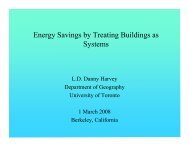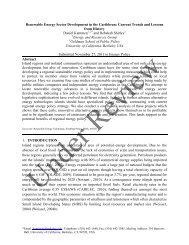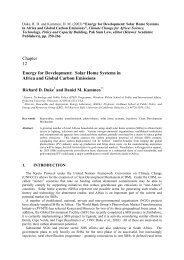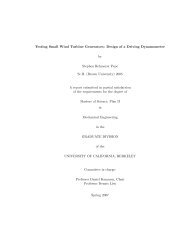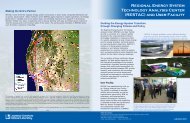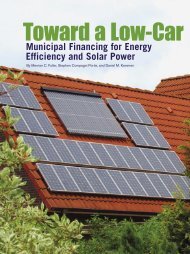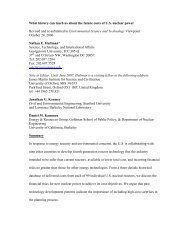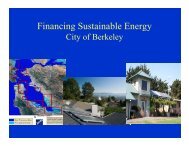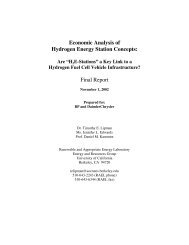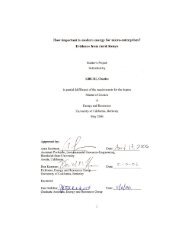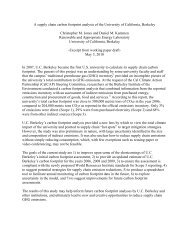Informing the Financing of Universal Energy Access: An Assessment ...
Informing the Financing of Universal Energy Access: An Assessment ...
Informing the Financing of Universal Energy Access: An Assessment ...
You also want an ePaper? Increase the reach of your titles
YUMPU automatically turns print PDFs into web optimized ePapers that Google loves.
ELECTR-5744; No <strong>of</strong> Pages 26UNFCCC (2007). We complement<strong>the</strong> existing literature by: Increasing <strong>the</strong> granularity interms <strong>of</strong> geographical coverageand providing data at <strong>the</strong> nationallevel for energy investments; Refining existing estimateswith additional informationfrom various complementarysources; and Providing an update on <strong>the</strong>existing figures by using <strong>the</strong> mostrecent available datasets.A. Flows consideredOur estimates are based on datafor a number <strong>of</strong> complementaryflows: Gross Fixed CapitalFormation 9 (GFCF), ForeignDirect Investments 10 (FDI), andOfficial Development Finance 11(ODF). (Appendix A providesdetailed national energy-relatedGFCF accounts. Appendix Bprovides supplementaryinformation with regard to energyinvestments in <strong>the</strong> CleanDevelopment Mechanism (CDM),merely as a point <strong>of</strong> comparison.)Table 1 presents a generaloverview <strong>of</strong> <strong>the</strong> financial flowsconsidered in this analysis. GFCFrepresents <strong>the</strong> total investmentflow. We include FDI and ODF toadd richness to <strong>the</strong> analysis. 12N ational and internationalstatistics <strong>of</strong>fices do notgenerally record <strong>the</strong> yearlyamount <strong>of</strong> domestic andinternational finance directed at<strong>the</strong> energy sector; available datathus present severe limitations. Weapply basic statistical tools toestimate missing values, andemploy several techniques to treatTable 1: Overview <strong>of</strong> Investment Flow Data. aType <strong>of</strong> flow Data source RemarkTotalGFCF UNSTAT b and WDI c Data include waterInternationalFDI UNCTAD Data include waterODFAidData da NFCCC (2007) also includes international debt as a source <strong>of</strong> financing for <strong>the</strong> energy, gas and water sector and anestimation <strong>of</strong> <strong>the</strong> source <strong>of</strong> <strong>the</strong> investment (households, corporations, government) for <strong>the</strong> total <strong>of</strong> all sectors (tables IV-8 and III-2, respectively). These data are <strong>the</strong> results <strong>of</strong> an economic model built for <strong>the</strong> year 2000. We estimate GFCF asa time series to obtain insights on trends.b UNSD (n.d.).c WB (n.d.).d Findley et al. (2010).<strong>the</strong> available data. The sectionbelow provides a detailedoverview <strong>of</strong> <strong>the</strong> data treatment foreach flow. All data are convertedinto USD 2000 using GDP deflatorsand exchange rates. 13 We focus on<strong>the</strong> timeframe 2000–2009, andutilize data from project leveldatabases (ODF and PrivateParticipation in Infrastructuredatabase 14 (PPI)) and data fromNational Accounts (GFCF andFDI). We recognize thatinvestment decisions in <strong>the</strong> projectlevel database may not reflectimmediately in <strong>the</strong> nationalaccounts, or may generate multiyearflows.1. GFCFGFCF data are aggregated forspecific sectors and/or for <strong>the</strong>entire economy. Here we areinterested in electricity, gasdistribution, and water supply, forwhich data are available only forselected countries. 15 For <strong>the</strong>countries with incomplete timeseries for this sector, we use <strong>the</strong>average national share from <strong>the</strong>years for which data is availableand compute <strong>the</strong> missing onesbased on <strong>the</strong> total GFCF for yearswhere it is not. Where sectorspecificdata are missingaltoge<strong>the</strong>r, we use a weightedaverage share <strong>of</strong> GFCF forelectricity, gas distribution, andwater supply over <strong>the</strong> total (3.8percent and 8.1 percent for OECDand non-OECD, respectively) andcompute it as a best approximationfor <strong>the</strong> missing national data. 16 It isimportant to note that that GFCFdata are based on nationalaccounts’ definitions <strong>of</strong> sectors,and <strong>the</strong>refore electricity, gasdistribution, and water are includedin <strong>the</strong> same sector. Comprehensivedatasets distinguishing <strong>the</strong> watercomponent from electricity, and gasdistribution do not exist. Weexclude <strong>the</strong> water component bysubtracting it from <strong>the</strong> total basedon <strong>the</strong> ratios 17 available inUNFCCC (2007), which are basedon OECD data.V arious investments in coal,oil, and gas production,processing, and transportationfacilities are spread across o<strong>the</strong>rsectors in <strong>the</strong> national accounts –mining and quarrying, industry,and transportation etc. – whichalso include o<strong>the</strong>r facilities.Therefore, compiling data on4 1040-6190/$–see front matter # 2011 Elsevier Inc. All rights reserved., doi:/10.1016/j.tej.2011.07.006 The Electricity JournalPlease cite this article in press as: Bazilian M, have surnames. <strong>Informing</strong> <strong>the</strong> <strong>Financing</strong> <strong>of</strong> <strong>Universal</strong> <strong>Energy</strong> <strong>Access</strong>: <strong>An</strong> <strong>Assessment</strong> <strong>of</strong> Current Financial FlowsElectr. J. (2011), doi:10.1016/j.tej.2011.07.006



